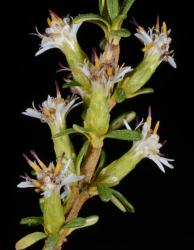- Taxon
- Gallery
- ≡ Eurybia solandri Hook.f., Bot. Antarct. Voy. II. (Fl. Nov.-Zel.) Part I, 119 (1853)
- ≡ Aster solandri (Hook.f.) F.Muell., Fragm. (Mueller) 5, 86 (1866)
- = Olearia fasciculifolia Colenso, Trans. & Proc. New Zealand Inst. 25: 330 (1892 [1893])
- = Olearia consimilis Colenso, Trans. & Proc. New Zealand Inst. 28: 596 (1895 [1896])
- = Olearia quinquefida Colenso, Trans. & Proc. New Zealand Inst. 28: 596 (1895 [1896])
Shrub or small tree up to 4 m. tall with rather stiff, spreading, angled, viscid branchlets clad in yellowish tomentum. Lvs of young plants and reversion shoots linear-spathulate, up to 1·5 cm. long, white-tomentose below; lvs of adult plants 5–10 mm. long, linear-obovate, on petioles c. 1 mm. long, subcoriac., glab. above when mature, clad in yellowish tomentum below, margins flat to slightly revolute. Capitula up to 10 × 5–7 mm., solitary, on short branchlets; florets 8–20, of ray up to 14; phyll. in 3–4 series, ∞, forming a narrow-turbinate involucre, fulvous, viscid-pubescent. Achenes 1–1·5 mm. long, glab. or nearly so, compressed, grooved; pappus-hairs 5–6 mm. long.
[From: Allan (1961) Flora of New Zealand. Volume 1.]
Flowering: Feb.–May.; Fruiting: Apr.–Jun.




